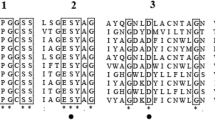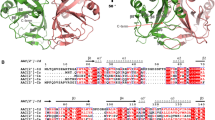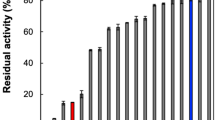Abstract
Bacteria possess proteases that are specific for the peptide bonds between D-alanine residues, one of which has a free α-carboxyl group. These D-alanyl-D-alanine peptidases catalyse carboxypeptidation and transpeptidation reactions involved in bacterial cell wall metabolism1,2, and are inactivated by β-lactam antibiotics. We have now elucidated the structure, at 2.5 Å resolution, of the penicillin-resistant Zn2+-containing D-alanyl-D-alanine peptidase of Streptomyces albus (Zn2+ G peptidase)3,4. The enzyme is shown to consist of two globular domains, connected by a single link. The N-terminal domain has three α-helices, and the C-terminal domain has three α-helices and five β-strands. The Zn2+ ion is ligated by three histidine residues, and located in a cleft in the C-terminal domain. The mechanism of action of the enzyme may be related to that of other carboxypeptidases, which also contain functional Zn2+ ions.
This is a preview of subscription content, access via your institution
Access options
Subscribe to this journal
Receive 51 print issues and online access
$199.00 per year
only $3.90 per issue
Buy this article
- Purchase on Springer Link
- Instant access to full article PDF
Prices may be subject to local taxes which are calculated during checkout
Similar content being viewed by others
References
Ghuysen, J. M. et al. in Topics in Molecular Pharmacology (eds Burgen, A. S. V. & Roberts, G. C. K.) 63–97 (Elsevier, Amsterdam, 1981).
Waxman, D. J., Yocum, R. R. & Strominger, J. L. Phil. Trans. R. Soc. B289, 257–271 (1980).
Frère, J. M. et al. Biochem. J. 143, 233–240 (1974).
Dideberg, O. et al. FEBS Lett. 117, 215–218 (1980).
Dideberg, O., Frère, J. M. & Ghuysen, J. M. J. molec. Biol. 129, 677–679 (1979).
Matthews, B. W. Acta crystallogr. 20, 82–86 (1966).
Joris, B. et al. Eur. J. Biochem. (submitted).
Levitt, H. & Chothia, C. Nature 261, 552–557 (1976).
Richardson, J. Proc. natn. Acad. Sci. U.S.A. 73, 2619–2623 (1976).
Dideberg, O. et al. FEBS Lett. 117, 212–214 (1980).
Hartsuck, J. A. & Lipscomb, W. N. in The Enzymes Vol. 3, 3rd edn (ed. Boyer, P. D.) 1–56 (Academic, New York, 1971).
Kester, W. R. & Matthews, B. W. J. biol. Chem. 252, 7704–7710 (1977).
Argos, P., Garavito, R. M., Eventoff, W., Rossmann, M. & Bränden, C. I. J. molec. Biol. 126, 141–158 (1978).
Kuo, L. C. & Makinen, M. W. J. biol. Chem. 257, 24–27 (1982).
Leyh-Bouille, M. et al. Biochemistry 9, 2961–2971 (1970).
Author information
Authors and Affiliations
Rights and permissions
About this article
Cite this article
Dideberg, O., Charlier, P., Dive, G. et al. Structure of a Zn2+-containing D-alanyl-D-alanine-cleaving carboxypeptidase at 2.5 Å resolution. Nature 299, 469–470 (1982). https://doi.org/10.1038/299469a0
Received:
Accepted:
Issue Date:
DOI: https://doi.org/10.1038/299469a0
This article is cited by
-
Comparative genomics reveals probable adaptations for xylose use in Thermoanaerobacterium saccharolyticum
Extremophiles (2024)
-
A unique class of Zn2+-binding serine-based PBPs underlies cephalosporin resistance and sporogenesis in Clostridioides difficile
Nature Communications (2022)
-
Functional and structural characterization of a novel putative cysteine protease cell wall-modifying multi-domain enzyme selected from a microbial metagenome
Scientific Reports (2016)
-
CREST - a large and diverse superfamily of putative transmembrane hydrolases
Biology Direct (2011)
-
Pharmacophore-based virtual screening versus docking-based virtual screening: a benchmark comparison against eight targets
Acta Pharmacologica Sinica (2009)
Comments
By submitting a comment you agree to abide by our Terms and Community Guidelines. If you find something abusive or that does not comply with our terms or guidelines please flag it as inappropriate.



